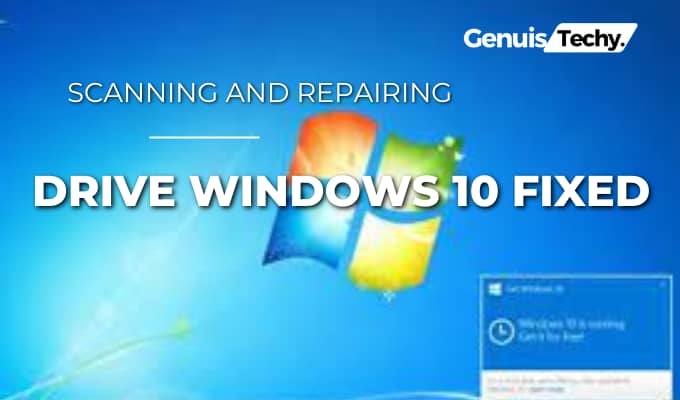Have you ever been greeted by the ominous message “Scanning and Repairing Drive” on your Windows 10 computer? It’s a digital red flag, signaling potential issues within your system. But fear not, as we embark on a journey where the once worrisome “scanning and repairing drive” Windows 10 fixed becomes a triumph.
Picture this: Your computer, a bustling metropolis of data, occasionally needs a bit of spring cleaning. That’s precisely what the “scanning and repairing drive” process does—it’s like a digital janitor tidying up your files. You’ll discover the magic behind those words as we delve into the intricacies. From mysterious glitches to the victorious resolution, this narrative unfolds how your Windows 10 device transforms from a puzzling problem child to a well-behaved digital companion. Join us on this expedition, where the phrase “scanning and repairing drive Windows 10 fixed” echoes like a mantra, guiding us through the maze of technological intricacies to a harmonious resolution.
What Does “Scanning and Repairing Drive” Mean in Windows 10?
When Windows 10 displays the message “Scanning and Repairing Drive,” it performs a digital health check on your storage drive. Think of it as your computer’s way of conducting routine maintenance, akin to a diligent custodian ensuring everything is in order. The operating system scans your drive for any potential errors or inconsistencies in the file system.
- Initiation of the Process:
The process is typically triggered during system startup or when Windows detects a potential issue with the drive. This could be due to unexpected shutdowns, power failures, or other events that may leave the file system inconsistent.
- File System Examination:
During the scan, Windows meticulously examines the file system on the drive, looking for discrepancies and irregularities. This step is crucial for maintaining your storage’s overall health and functionality.
- Error Correction:
If any issues are found during the scan, Windows automatically initiates the repair phase. It corrects errors, ensuring the file system is coherent and reliable. This proactive approach helps prevent potential data corruption and keeps your system running smoothly.
- Duration of the Process:
The duration of the “Scanning and Repairing Drive” process can vary based on factors such as the size of the drive and the extent of issues detected. Patience is key, as it’s a meticulous operation aimed at preserving the integrity of your data.
- Preventive Measures:
To minimize the occurrence of such scans, practice safe computing habits. Regularly back up your important data, avoid abrupt shutdowns, and use reliable hardware to reduce the likelihood of file system errors.
Stop Windows 10 from scanning and fixing drives:
If you’ve found yourself caught in the endless loop of “Scanning and Repairing Drive” in Windows 10, fear not – relief is at hand. Follow this guide to halt the process and fix any underlying issues.
Boot Windows 10 into Safe Mode:
To break free from the scanning and repairing cycle, start by booting your Windows 10 system into Safe Mode. This can be done by restarting your computer and pressing the F8 key repeatedly before the Windows logo appears. Once in Safe Mode, Windows limits its functionality to essential processes, providing a stable environment for troubleshooting.
Advertisements:
Before proceeding to the next steps, ensure you’ve backed up your important data.
The following methods will help you fix your drive:
Method 1: Check Drive for File System Errors:
On the Start menu, type “Command Prompt”. Right-click on it and select “Run as administrator.” In the Command Prompt window, type “chkdsk /f” and press Enter. This command checks and fixes file system errors on the drive.
Method 2: Run CHKDSK:
Still, facing issues? Run CHKDSK (Check Disk) to identify and repair disk-related problems. As an administrator, open Command Prompt and type “chkdsk /r” followed by the drive letter (e.g., C :). Press Enter and let Windows fix any detected problems during the next system restart.
Conclusion:
In conclusion, resolving the “Scanning and Repairing Drive” issue in Windows 10 marks a triumph over digital adversity. Through strategic steps like booting into Safe Mode and employing targeted commands such as “chkdsk,” the persistent problem is not only halted but effectively fixed. Users can now enjoy a Windows 10 experience free from the repetitive scanning process, showcasing the resilience of the system and the efficacy of the troubleshooting methods employed. This concise guide empowers users with practical solutions, ensuring a swift resolution to a common and irritating issue.
FAQs:
Q.1: Is Scanning and repairing the drive normal?
No, “Scanning and Repairing Drive” is not a normal occurrence. It usually indicates potential issues with the drive, and attention is needed to address and resolve underlying problems.
Q.2: How do I fix Scanning and repairing drives in Windows 10?
To fix “Scanning and Repairing Drives” in Windows 10, boot into Safe Mode, then use Command Prompt to run “chkdsk /f” to check and fix file system errors. If issues persist, run “chkdsk /r” to comprehensively address disk-related problems.
Q.3: Why is my PC Scanning and repairing drive every startup?
Your PC is scanning and repairing the drive on every startup likely due to file system errors or issues with the disk. This process aims to ensure the integrity of your data and maintain the health of your system. Running utilities like CHKDSK or booting into Safe Mode can help address and fix these underlying problems, preventing repetitive scanning behavior.
Q.4: How long does the Scanning and Repairing drive take Windows 10?
The duration of “Scanning and Repairing Drive” in Windows 10 varies based on factors like drive size and system performance. A few minutes to several hours can pass.
